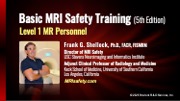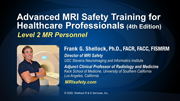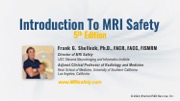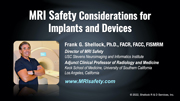A complete listing of currently available online programs is provided below. To view course materials click an available viewing format provided with each listing (PDF, HTML, Interactive). To access online exams and claim credit you must be registered and logged in. To add courses to your "MyAR Archives" user account select the "Add To Cart" button provided with each course title and follow the prompts.
|
* Basic MRI Safety Training (5th Edition) | Level 1 MR Personnel
|
|
Released:
July 10, 2025
•Expires:
August 31, 2028
|
CE credits:
1.0
• Cost:
$30.00
|
|
Faculty:
Frank G. Shellock, PhD, FACC, FACR, FACSM
|

Individuals entering the magnetic resonance imaging (MRI) environment, whether on a regular or infrequent basis, must be properly trained to ensure their safety, the protection of patients, the security of facility staff members, and others. This program, Basic MRI Safety Training (5th Edition), Level 1 MR Personnel, accomplishes the training that is necessary to ensure safety in the unique setting associated with the MRI system and includes information pertaining to MRI technology, describes common hazards and unique dangers associated with the MRI setting, and presents vital guidelines to prevent accidents and injuries.
With more than 40 years of experience in the field of MRI, the author of the best-selling textbooks, the Reference Manual for Magnetic Resonance Safety, Implants and Devices (19 editions), and the creator of the internationally popular website, www.MRIsafety.com, Dr. Frank G. Shellock is uniquely qualified to present the information provoded in this program.
Educational Objectives
-
Appreciate the importance of MRI as an imaging modality
-
Identify the hazards associated with MRI
-
Understand the MRI safety screening process
-
Describe steps to prevent accidents and injuries
This is a Pay-To-View program. Purchase is required for full program access.
|
|
|
|
|
* Advanced MRI Safety Training For Healthcare Professionals (4th Edition): Level 2 MR Personnel
|
|
Released:
April 22, 2020
•Expires:
April 30, 2026
|
CE credits:
3.0
• Cost:
$50.00
|
|
Faculty:
Frank G. Shellock, PhD, FACC, FACR, FACSM
|

This program reviews fundamental MRI safety information and meets the annual training recommendations from the American College of Radiology. Importantly, MRI facilities must now comply with the revised requirements for diagnostic imaging from The Joint Commission and document that MRI technologists participate in ongoing education that includes annual training on safe MRI practices in the MRI environment. Notably, Advanced MRI Safety Training for Healthcare Professionals, Level 2 MR Personnel covers each MRI safety topic specified by The Joint Commission, as well as many additional subjects that will expand the knowledge-base of healthcare professionals involved with MRI technology.
With 35 years of experience in the field of MRI, the author of the best-selling textbook series, the Reference Manual for Magnetic Resonance Safety, Implants and Devices, and the creator of the internationally popular website, MRIsafety.com, Dr. Frank G. Shellock is uniquely qualified to present the information in this program.
Advanced MRI Safety Training for Healthcare Professionals (4th Edition), Level 2 MR Personnel is a 2 hour and 45 minute program that is divided into three different sections.
Educational Objectives
-
Understand the safety issues related to MRI.
-
Describe the bioeffects associated with the static magnetic field, time-varying magnetic fields, and radiofrequency fields.
-
Present guidelines that prevent projectile-related accidents.
-
Describe polices that avoid issues related to acoustic noise.
-
Review procedures that prevent burns associated with MRI.
-
Explain and demonstrate appropriate pre-MRI screening procedures.
-
Identify techniques to manage patients with claustrophobia, anxiety, or emotional distress.
-
Describe guidelines to handle medical emergencies in the MRI setting.
-
Understand the safety considerations for gadolinium-based contrast agents.
This is a Pay-To-View program. Purchase is required for full program access.
|
|
|
|
|
* Introduction To MRI Safety (5th Edition)
|
|
Released:
September 1, 2024
•Expires:
August 31, 2028
|
CE credits:
0
• Cost:
$15.00
|
|
Faculty:
Frank G. Shellock, PhD, FACC, FACR, FACSM
|

This program provides an overview of MRI safety information that is intended for non-clinical staff members who regularly work in the MRI environment or who may occasionally work in this area as part of their responsibilities. Anyone who enters the MRI environment, even infrequently, must be properly trained to ensure their safety, the safety of patients, and other facility staff members
After completion of a short online exam, with a passing score of 70% or higher, this program provides a Statement of Participation.
With more than 40 years of experience in the field of MRI, Dr. Shellock has authored more than 280 publications in the peer-reviewed literature. His medical textbooks include the Reference Manual for Magnetic Resonance Safety, Implants and Devices (19 editions) and MRI Bioeffects, Safety, and Patient Management (2 editions). As an internationally respected, MRI safety researcher and educator, Dr. Shellock, is uniquely qualified to present the information in this program
Educational Objectives
-
Appreciate the importance of MRI
-
Identify the certain hazards associated with MRI technology
-
Describe steps to prevent accidents and injuries related to ferromagnetic objects
This is a Pay-To-View program. Purchase is required for full program access.
|
|
|
|
|
Clinical Applications of MR Imaging in Stereotactic Localization Radiosurgery Procedures
|
|
Released:
January 2, 2024
•Expires:
January 31, 2027
|
CE credits:
1.5
• Cost:
$0.00
|
|
Faculty:
Jenny WU, MD | Glen Stevens, DO, PhD
|

Gadolinium-based contrast agents (GBCAs) are essential for enhancing the quality of MRI scans to make it easier for radiologists to identify pathology. The US Food and Drug Administration (FDA) and the American College of Radiology (ACR) recommend limiting patient exposure to gadolinium where possible.
One technique for reducing this exposure is to use a high relaxivity GBCA that can be administered at a lower dose than a conventional GBCA, without any impact on image quality. GBCA selection for interventional procedures such as radiosurgery is one such example, where the selection of a GBCA can play a role in patient management and outcomes.
In this program, an experienced neuroradiologist and neuro oncologist will present their clinical experiences with the use of stereotactic localization radiosurgery, following the administration of a high relaxivity GBCA. Through case study examples, the clinical impact of contrast selection will be demonstrated. Following the presentation, questions from the audience will be addressed during a live Q&A.
Educational Objectives:
At the completion of this activity, participants should be able to:
-
Review the role of stereotactic radiosurgery (SRS) for brain metastases and the role of pre-operative localization MRI exams for stereotactic radiosurgery.
-
Outline the differences between gadopiclenol and other group II gadolinium-based contrast agents.
-
Discuss the use of gadopiclenol in specific case-based scenarios for stereotactic localization exams and its impact on patient management.
This program is made possible through an unrestricted educational grant from Guerbet.
|
|
|
|
|
CT Power Injection Challenges | PICC Line Malposition
|
|
Released:
January 2, 2024
•Expires:
January 31, 2027
|
CE credits:
1.0
• Cost:
$0.00
|
|
Faculty:
Applied Radiology
|

This CE accredited program provides an educational resource that addresses current and future iodinated contrast media shortages and its clinical impact.
Although power injectable peripherally inserted catheters (PICC) are deemed to be relatively safe for use with CT power injectors, there have been reports of PICC tip malposition as a result of higher flow rates and the pressure required to properly administer iodinated IV contrast during CT procedures. Any malpositioning of a PICC can pose a risk to patients, including catheter failure, thrombosis, phlebitis, arrhythmia, and pain.
In this CE accredited Expert Forum Webinar, Dr. John Schmitz, an Assistant Professor of Radiology and his colleague, Ms. Nicole Jensen, a Radiology Nurse Manager discuss an effective approach to managing PICC tip malposition following the delivery of IV contrast when using a CT power injector and a power-injectable PICC.
In addition, they will share best practices, which include obtaining a pre-injection and post-injection topogram to ensure the PICC catheter position prior to, and following the contrast injection and the value of using a rapid saline flush to reposition the catheter tip.
Educational Objectives:
At the completion of this activity, participants should be able to:
-
Implement a protocol for obtaining the Power Injectable PICC tip position prior to, and following a contrast-enhanced CT
-
Implement a protocol to manage a Power Injectable PICC tip malposition occurrence following power injection to minimize any risk to patients.
This program has been sponsored by Bayer Healthcare.
|
|
|
|
|
MRI Safety Considerations for Implants and Devices
|
|
Released:
February 1, 2023
•Expires:
February 28, 2026
|
CE credits:
1.5
• Cost:
$30.00
|
|
Faculty:
Frank G. Shellock, PhD, FACC, FACR, FACSM
|

This accredited program provides a comprehensive overview of MRI safety considerations for passive / active implants, and devices.
When considering patient safety during MR imaging, it is critical to assess the patient’s history and have a clear understanding of any passive and or active implants and/or devices. The ACR Manual on MR Safety states that the Radiologist is responsible for the safety of the patient undergoing the MRI Exam. They are also responsible for implementing MR Safety policies and procedures and ensuring that the facilities’ personnel adhere to them at all time. Regarding implants and devices, regular reviews and updates to the MRI safety policy should be completed.
With more than 35 years of experience in the field of MRI, the author of the best-selling textbook series, the Reference Manual for Magnetic Resonance Safety, Implants and Devices, and the creator of the internationally popular website, www.MRIsafety.com, Dr. Frank G. Shellock is uniquely qualified to present this important MRI Safety information designed for MRI Imaging professionals.
Educational Objectives
-
Name and describe the current labeling terminology for implants & devices.
-
Safely image patients with passive and active, MR Conditional implants and devices.
-
Establish a comprehensive MRI Safety protocol for imaging implants & devices.
Program support provided by Bracco Diagnostics, Inc.
This is a Pay-To-View program. Purchase is required for full program access.
|
|
|
|
|
MRI Safety Considerations For The Radiologist
|
|
Released:
February 16, 2023
•Expires:
February 28, 2026
|
CE credits:
1.5
• Cost:
$30.00
|
|
Faculty:
William Faulkner, B.S.,R.T.(R)(MR)(CT), FSMRT | Kristan Harrington, MBA, R.T.(R)(MR), ARRT, MRSO
|

This accredited program provides a comprehensive overview of MRI safety including the radiologist's responsibilities and liabilities, MRI staff education and patient safety. It is designed specifically for practicing radiologists, fellows, residents, and healthcare professionals who oversee MRI services and will provide practical guidance from two respected MRI safety educators who present information on accepted safety standards of care based on the 2020 ACR Manual on MR Safety, the 2021 FDA Guidance Document, and a review of the literature.
Program Considerations: It is critical to have established MRI safety protocols and to have a clear understanding of the basics of MRI Safety. The ACR Manual on MR Safety states that the Radiologist is responsible for the safety of the patient undergoing the MRI Exam. They are also responsible for implementing MR Safety policies and procedures and ensuring that the facilities’ personnel adhere to them at all time. These MRI safety policies should be reviewed and updated annually in order to prevent patient injury.
Educational Objectives
-
Describe the difference between Level 1 & Level 2 MR personnel.
-
Differentiate and identify the ACR-designated Safety Zones.
-
Implement safety considerations for the static magnetic field, time-varying gradient magnetic fields, and radiofrequency fields.
-
Employ procedures and protocols to prevent RF-related burns and methods to manage SAR levels.
-
Manage acute and chronic gadolinium-based contrast agent adverse events.
Program support provided by Bracco Diagnostics, Inc.
This is a Pay-To-View program. Purchase is required for full program access.
|
|
|
|
|
Neuro MRI with Gadopiclenol
|
|
Released:
October 8, 2024
•Expires:
October 31, 2027
|
CE credits:
1.0
• Cost:
$0.00
|
|
Faculty:
Pareen Mehta, MD
|

While GBCAs are essential to performing neuro MR imaging, guidance from the US Food and Drug Administration (FDA) and the American College of Radiology (ACR) includes the recommendation of limiting a patient's gadolinium exposure
One technique for reducing gadolinium exposure is to use a high-relaxivity gadolinium-based contrast agent (GBCA) that can be administered at a lower dose than a conventional GBCA without deteriorating image quality. Gadopiclenol, recently received FDA approval and is a high-relaxivity GBCA, designed to generate high-quality images at half the conventional dose of other GBCAs
This educational program provides the clinical rationale for adopting the use of Gadopiclenol for neuro MRI and includes practice considerations for changing from one GBCA to another.
Through case study reviews, Pareen Mehta, MD, will share clinical insights into achieving optimal image quality using a lower administered gadolinium dose when performing neuro MRI.
Educational Objectives:
At the completion of this activity, participants should be able to:
-
Understand and employ the clinical indications for neuro MRI using gadopiclenol.
-
Apply clinical considerations for lower neuro MRI gadolinium dosing protocols as compared to other GBCAs in neuroradiology.
-
Utilize neuro MR imaging protocols using gadopiclenol to achieve optimal image quality and diagnostic confidence.
This program is an educational activity sponsored by Guerbet, LLC.
|
|
|
|